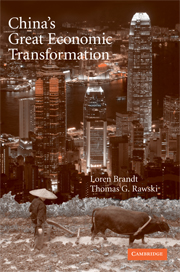Book contents
- Frontmatter
- Contents
- List of Figures
- List of Tables
- Contributors
- Acknowledgments
- Map
- 1 China's Great Economic Transformation
- 2 China and Development Economics
- 3 China in Light of the Performance of the Transition Economies
- 4 A Political Economy of China's Economic Transition
- 5 The Demographic Factor in China's Transition
- 6 The Chinese Labor Market in the Reform Era
- 7 Education in the Reform Era
- 8 Environmental Resources and Economic Growth
- 9 Science and Technology in China
- 10 The Political Economy of Private Sector Development in China
- 11 The Role of Law in China's Economic Development
- 12 China's Fiscal System: A Work in Progress
- 13 Agriculture in China's Development: Past Disappointments, Recent Successes, and Future Challenges
- 14 China's Financial System: Past, Present, and Future
- 15 China's Industrial Development
- 16 China's Embrace of Globalization
- 17 Growth and Structural Transformation in China
- 18 Income Inequality during China's Economic Transition
- 19 Spatial Dimensions of Chinese Economic Development
- 20 Forecasting China's Economic Growth to 2025
- Index
15 - China's Industrial Development
Published online by Cambridge University Press: 24 May 2010
- Frontmatter
- Contents
- List of Figures
- List of Tables
- Contributors
- Acknowledgments
- Map
- 1 China's Great Economic Transformation
- 2 China and Development Economics
- 3 China in Light of the Performance of the Transition Economies
- 4 A Political Economy of China's Economic Transition
- 5 The Demographic Factor in China's Transition
- 6 The Chinese Labor Market in the Reform Era
- 7 Education in the Reform Era
- 8 Environmental Resources and Economic Growth
- 9 Science and Technology in China
- 10 The Political Economy of Private Sector Development in China
- 11 The Role of Law in China's Economic Development
- 12 China's Fiscal System: A Work in Progress
- 13 Agriculture in China's Development: Past Disappointments, Recent Successes, and Future Challenges
- 14 China's Financial System: Past, Present, and Future
- 15 China's Industrial Development
- 16 China's Embrace of Globalization
- 17 Growth and Structural Transformation in China
- 18 Income Inequality during China's Economic Transition
- 19 Spatial Dimensions of Chinese Economic Development
- 20 Forecasting China's Economic Growth to 2025
- Index
Summary
INTRODUCTION
China's industries have achieved remarkable development since the start of reform in the late 1970s. Although this chapter will outline both the quantitative and institutional dimensions of recent growth, its chief objective is to examine what we see as the central achievement of Chinese industry: the emergence of mechanisms for extending industrial capability, which we measure by the capacity to sell into overseas markets, to a growing array of products and sectors. This accomplishment, which only a few economies – among them Taiwan, South Korea, Israel, India, and Brazil – have matched since the end of World War II, ensures that China's recent boom represents a permanent shift rather than a temporary respite from centuries of poverty.
At the start of reform, Chinese industry had already attained substantial size. Chinese factories and mines employed more workers in 1978 than the combined total of all other third-world nations. Success with nuclear weapons and satellite technology demonstrated new technical strength. Yet, visitors to Chinese factories encountered obsolete and dysfunctional products: vans and transformers that failed to keep out rainwater, sewing machines that leaked oil onto the fabric, power tillers rusting outside a factory that churned out fresh batches of unwanted inventory, and so on.
- Type
- Chapter
- Information
- China's Great Economic Transformation , pp. 569 - 632Publisher: Cambridge University PressPrint publication year: 2008
- 38
- Cited by



